MITSUBISHI MIRAGE G4 2020 (in English) Owner's Guide
Manufacturer: MITSUBISHI, Model Year: 2020, Model line: MIRAGE G4, Model: MITSUBISHI MIRAGE G4 2020Pages: 253, PDF Size: 36.39 MB
Page 31 of 253
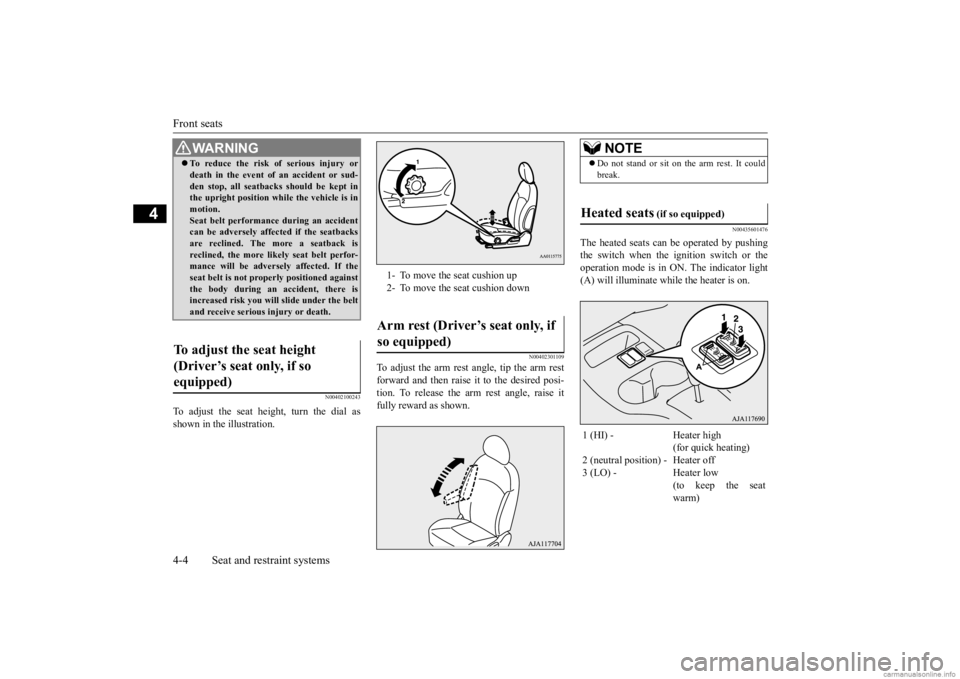
Front seats 4-4 Seat and restraint systems
4
N00402100243
To adjust the seat height, turn the dial as shown in the illustration.
N00402301109
To adjust the arm rest angle, tip the arm rest forward and then raise it to the desired posi- tion. To release the arm rest angle, raise it fully reward as shown.
N00435601476
The heated seats can
be operated by pushing
the switch when the ignition switch or theoperation mode is in ON. The indicator light (A) will illuminate while the heater is on.
WA R N I N G To reduce the risk of serious injury or death in the event of
an accident or sud-
den stop, all seatbacks should be kept inthe upright position while the vehicle is in motion. Seat belt performance during an accidentcan be adversely affect
ed if the seatbacks
are reclined. The more a seatback is reclined, the more likely seat belt perfor-mance will be adversely affected. If the seat belt is not proper
ly positioned against
the body during an accident, there isincreased risk you will slide under the belt and receive serious
injury or death.
To adjust the seat height (Driver’s seat only, if so equipped)
1- To move the seat cushion up 2- To move the seat cushion downArm rest (Driver’s seat only, if so equipped)
NOTE
Do not stand or sit on the arm rest. It could break.
Heated seats
(if so equipped)
1 (HI) - Heater high
(for quick heating)
2 (neutral position) - Heater off 3 (LO) - Heater low
(to keep the seat warm)
BK0284300US.book 4 ページ 2019年5月23日 木曜日 午後12時22分
Page 32 of 253
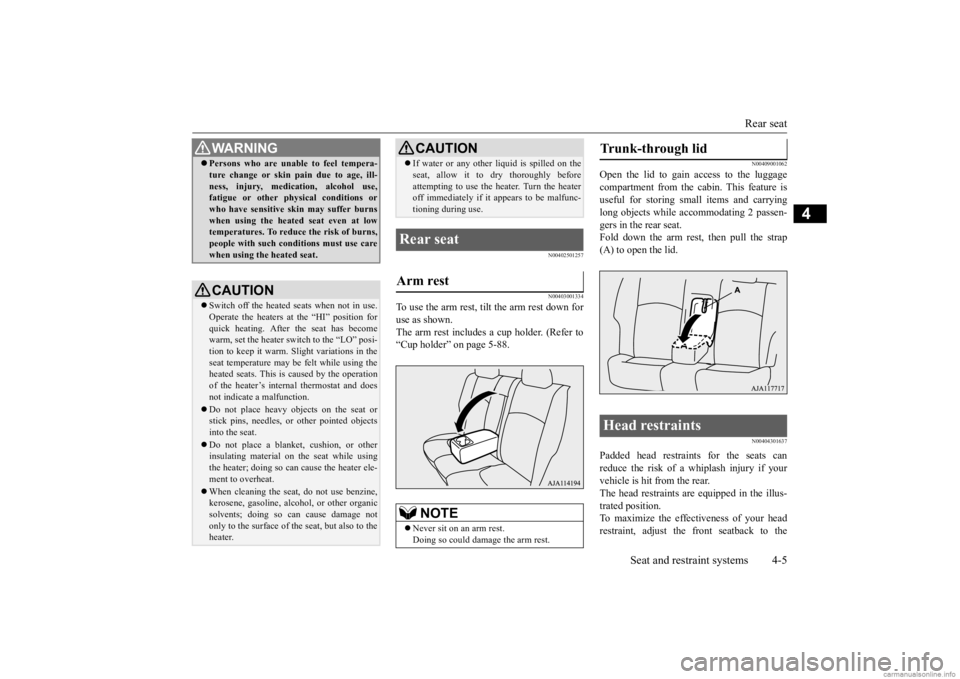
Rear seat
Seat and restraint systems 4-5
4
N00402501257 N00403001334
To use the arm rest, tilt the arm rest down for use as shown. The arm rest includes a cup holder. (Refer to“Cup holder” on page 5-88.
N00409001062
Open the lid to gain access to the luggage compartment from the cabin. This feature is useful for storing small items and carryinglong objects while ac
commodating 2 passen-
gers in the rear seat. Fold down the arm rest, then pull the strap(A) to open the lid.
N00404301637
Padded head restraints for the seats can reduce the risk of a whiplash injury if your vehicle is hit from the rear.The head restraints are equipped in the illus- trated position. To maximize the effectiveness of your headrestraint, adjust the front seatback to the
WA R N I N G Persons who are unable to feel tempera- ture change or skin
pain due to age, ill-
ness, injury, medication, alcohol use,fatigue or other phys
ical conditions or
who have sensitive sk
in may suffer burns
when using the heated seat even at lowtemperatures. To reduce the risk of burns, people with such conditions must use care when using the heated seat.CAUTION Switch off the heated seats when not in use. Operate the heaters at the “HI” position for quick heating. After the seat has become warm, set the heater switch to the “LO” posi-tion to keep it warm. Sl
ight variations in the
seat temperature may be felt while using the heated seats. This is caused by the operationof the heater’s internal thermostat and does not indicate
a malfunction.
Do not place heavy objects on the seat or stick pins, needles, or
other pointed objects
into the seat. Do not place a blanket,
cushion, or other
insulating material on the seat while usingthe heater; doing so can
cause the heater ele-
ment to overheat. When cleaning the seat, do not use benzine, kerosene, gasoli
ne, alcohol, or other organic
solvents; doing so can cause damage not only to the surface of the seat, but also to theheater.
If water or any other li
quid is spilled on the
seat, allow it to dry thoroughly beforeattempting to use the heater. Turn the heateroff immediately if it
appears to be malfunc-
tioning during use.
Rear seat Arm rest
NOTE
Never sit on an arm rest. Doing so could damage the arm rest.CAUTION
Trunk-through lid Head restraints
BK0284300US.book 5 ページ 2019年5月23日 木曜日 午後12時22分
Page 33 of 253
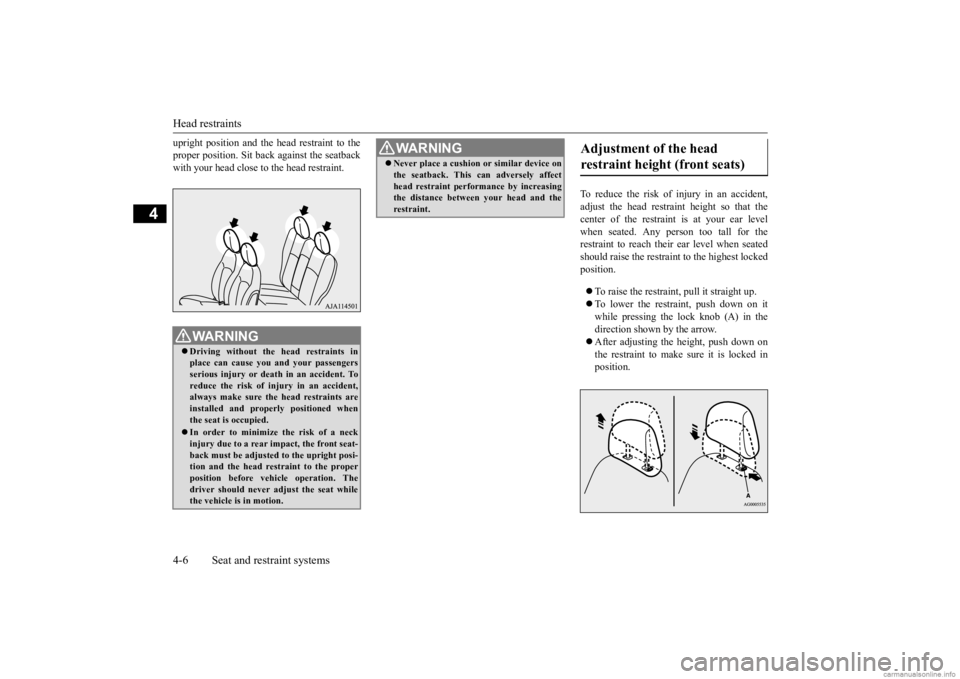
Head restraints 4-6 Seat and restraint systems
4
upright position and the head restraint to the proper position. Sit back
against the seatback
with your head close to the head restraint.
To reduce the risk of injury in an accident, adjust the head restraint height so that thecenter of the restrain
t is at your ear level
when seated. Any person too tall for the restraint to reach their ear level when seatedshould raise the restraint to the highest locked position. To raise the restraint, pull it straight up. To lower the restraint, push down on it while pressing the lock knob (A) in the direction shown by the arrow. After adjusting the height, push down on the restraint to make sure it is locked in position.
WA R N I N G Driving without the
head restraints in
place can cause you and your passengers serious injury or deat
h in an accident. To
reduce the risk of injury in an accident,always make sure the head restraints are installed and proper
ly positioned when
the seat is occupied. In order to minimize the risk of a neck injury due to a rear impact, the front seat-back must be adjusted to the upright posi- tion and the head restraint to the proper position before vehi
cle operation. The
driver should never ad
just the seat while
the vehicle is in motion.
Never place a cushion
or similar device on
the seatback. This can adversely affecthead restraint performance by increasingthe distance between your head and the restraint.WA R N I N G
Adjustment of the head restraint height (front seats)
BK0284300US.book 6 ページ 2019年5月23日 木曜日 午後12時22分
Page 34 of 253
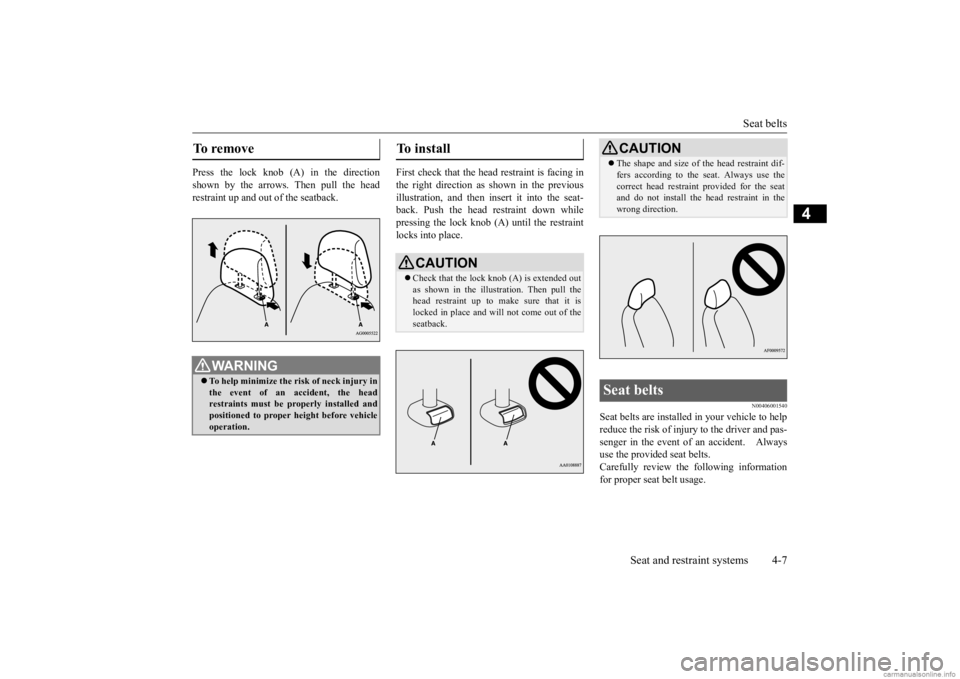
Seat belts
Seat and restraint systems 4-7
4
Press the lock knob (A) in the direction shown by the arrows. Then pull the head restraint up and out of the seatback.
First check that the head restraint is facing in the right direction as
shown in the previous
illustration, and then insert it into the seat- back. Push the head restraint down whilepressing the lock knob (A) until the restraint locks into place.
N00406001540
Seat belts are installed in your vehicle to help reduce the risk of injury to the driver and pas- senger in the event of an accident. Always use the provided seat belts.Carefully review the
following information
for proper seat belt usage.
To remove
WA R N I N G To help minimize the risk of neck injury in the event of an accident, the headrestraints must be properly installed and positioned to proper height before vehicle operation.
To install
CAUTION Check that the lock knob (A) is extended out as shown in the illustration. Then pull the head restraint up to make sure that it islocked in place and will
not come out of the
seatback.
CAUTION The shape and size of the head restraint dif- fers according to the seat. Always use thecorrect head restrain
t provided for the seat
and do not install the he
ad restraint in the
wrong direction.
Seat belts
BK0284300US.book 7 ページ 2019年5月23日 木曜日 午後12時22分
Page 35 of 253
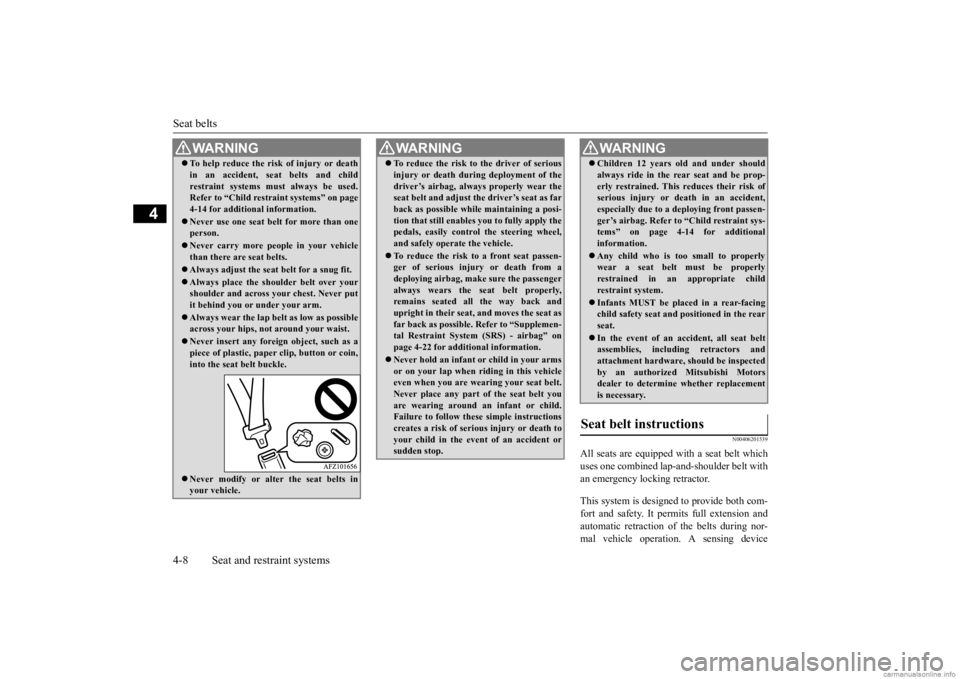
Seat belts 4-8 Seat and restraint systems
4
N00406201539
All seats are equipped with a seat belt which uses one combined lap-
and-shoulder belt with
an emergency locking retractor. This system is designed to provide both com- fort and safety. It permits full extension andautomatic retraction of the belts during nor- mal vehicle operation.
A sensing device
WA R N I N GTo help reduce the risk of injury or death in an accident, se
at belts and child
restraint systems must always be used.Refer to “Child restraint systems” on page 4-14 for additional information. Never use one seat belt
for more than one
person. Never carry more peop
le in you
r vehicle
than there are seat belts. Always adjust the seat
belt for a snug fit.
Always place the shou
lder belt over your
shoulder and across
your chest. Never put
it behind you or under your arm. Always wear the lap be
lt as low as possible
across your hips, not around your waist. Never insert any foreig
n object, such as a
piece of plastic, paper
clip, button or coin,
into the seat belt buckle. Never modify or alter the seat belts in your vehicle.
To reduce the risk to the driver of serious injury or death durin
g deployment of the
driver’s airbag, always
properly wear the
seat belt and adjust th
e driver’s seat as far
back as possible while maintaining a posi- tion that still enables
you to fully apply the
pedals, easily control the steering wheel, and safely operate the vehicle. To reduce the risk to a front seat passen- ger of serious injury or death from a deploying airbag, make sure the passengeralways wears the seat belt properly, remains seated all the way back and upright in their seat,
and moves the seat as
far back as possible. Refer to “Supplemen- tal Restraint System (SRS) - airbag” on page 4-22 for additional information. Never hold an infant
or child in your arms
or on your lap
when riding in this vehicle
even when you are wearing your seat belt. Never place any part of the seat belt you are wearing around an
infant or child.
Failure to follow these simple instructions creates a risk of serious injury or death to your child in the even
t of an accident or
sudden stop.WA R N I N G
Children 12 years ol
d and under should
always ride in the re
ar seat and be prop-
erly restrained. This reduces their risk ofserious injury or de
ath in an accident,
especially due to a deploying front passen- ger’s airbag. Refer to
“Child restraint sys-
tems” on page 4-
14 for additional
information. Any child who is too small to properly wear a seat belt
must be properly
restrained in an appropriate childrestraint system. Infants MUST be plac
ed in a rear-facing
child safety seat and
positioned in the rear
seat. In the event of an ac
cident, all seat belt
assemblies, including retractors and attachment hardware, should be inspectedby an authorized
Mitsubishi Motors
dealer to determine whether replacement is necessary.
Seat belt instructions
WA R N I N G
BK0284300US.book 8 ページ 2019年5月23日 木曜日 午後12時22分
Page 36 of 253
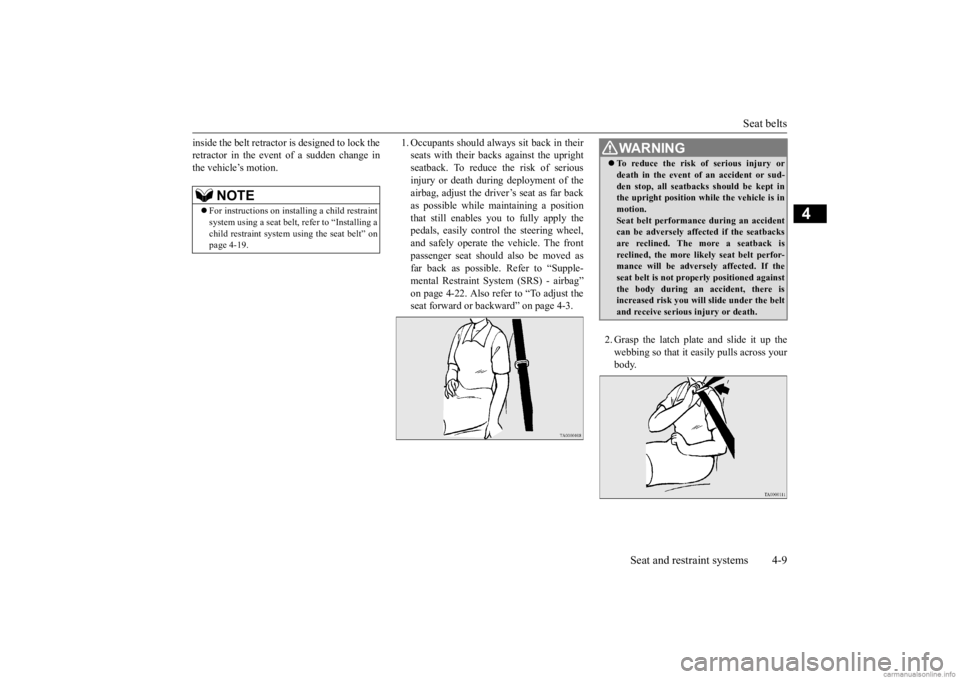
Seat belts
Seat and restraint systems 4-9
4
inside the belt retractor is designed to lock the retractor in the event of a sudden change inthe vehicle’s motion.
1. Occupants should always
sit back in their
seats with their backs against the uprightseatback. To reduce
the risk of serious
injury or death during deployment of the airbag, adjust the driver’s seat as far backas possible while maintaining a position that still enables you to fully apply the pedals, easily control the steering wheel,and safely operate the vehicle. The front passenger seat should also be moved as far back as possible. Refer to “Supple- mental Restraint System (SRS) - airbag” on page 4-22. Also refer to “To adjust theseat forward or backward” on page 4-3.
2. Grasp the latch plat
e and slide it up the
webbing so that it easily pulls across your body.
NOTE
For instructions on installing a child restraint system using a seat belt
, refer to “Installing a
child restraint system
using the seat belt” on
page 4-19.
WA R N I N G To reduce the risk of serious injury or death in the event of
an accident or sud-
den stop, all seatbacks should be kept inthe upright position while the vehicle is in motion. Seat belt performance during an accidentcan be adversely affect
ed if the seatbacks
are reclined. The more a seatback is reclined, the more likely seat belt perfor-mance will be advers
ely affected. If the
seat belt is not prop
erly positioned against
the body during an accident, there isincreased risk you will slide under the belt and receive serious
injury or death.
BK0284300US.book 9 ページ 2019年5月23日 木曜日 午後12時22分
Page 37 of 253
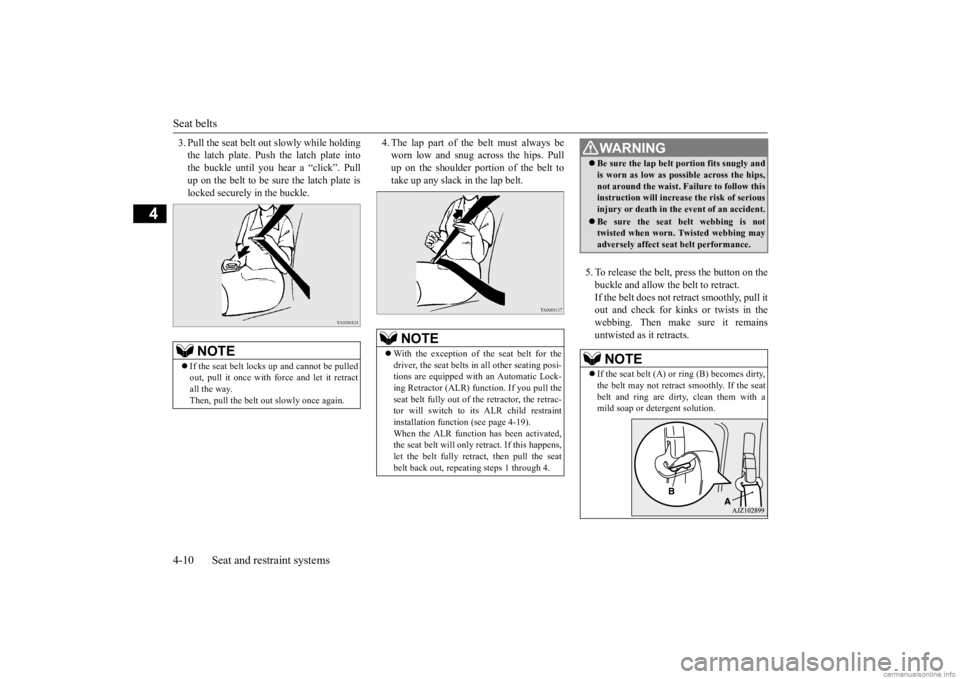
Seat belts 4-10 Seat and restraint systems
4
3. Pull the seat belt out slowly while holding the latch plate. Push the latch plate intothe buckle until you hear a “click”. Pull up on the belt to be su
re the latch plate is
locked securely in the buckle.
4. The lap part of the belt must always be worn low and snug across the hips. Pullup on the shoulder portion of the belt to take up any slack
in the lap belt.
5. To release the belt,
press the button on the
buckle and allow the belt to retract. If the belt does not retract smoothly, pull it out and check for kinks or twists in thewebbing. Then make sure it remains untwisted as it retracts.
NOTE
If the seat belt locks
up and cannot be pulled
out, pull it once with force and let it retract all the way. Then, pull the belt out
slowly once again.
NOTE
With the exception of the seat belt for the driver, the seat belts in all other seating posi-tions are equipped with an Automatic Lock- ing Retractor (ALR) function. If you pull the seat belt fully out of th
e retractor, the retrac-
tor will switch to its ALR child restraint installation function
(see page 4-19).
When the ALR function has been activated,the seat belt will only re
tract. If this happens,
let the belt fully retract, then pull the seat belt back out, repeating steps 1 through 4.
WA R N I N G Be sure the lap belt portion fits snugly and is worn as low as possible across the hips,not around the waist. Failure to follow thisinstruction will increase the risk of serious injury or death in the
event of an accident.
Be sure the seat belt webbing is not twisted when worn. Twisted webbing may adversely affect seat belt performance.NOTE
If the seat belt (A) or
ring (B) becomes dirty,
the belt may not retrac
t smoothly. If the seat
belt and ring are dirty, clean them with a mild soap or detergent solution.
BK0284300US.book 10 ページ 2019年5月23日 木曜日 午後12時22分
Page 38 of 253
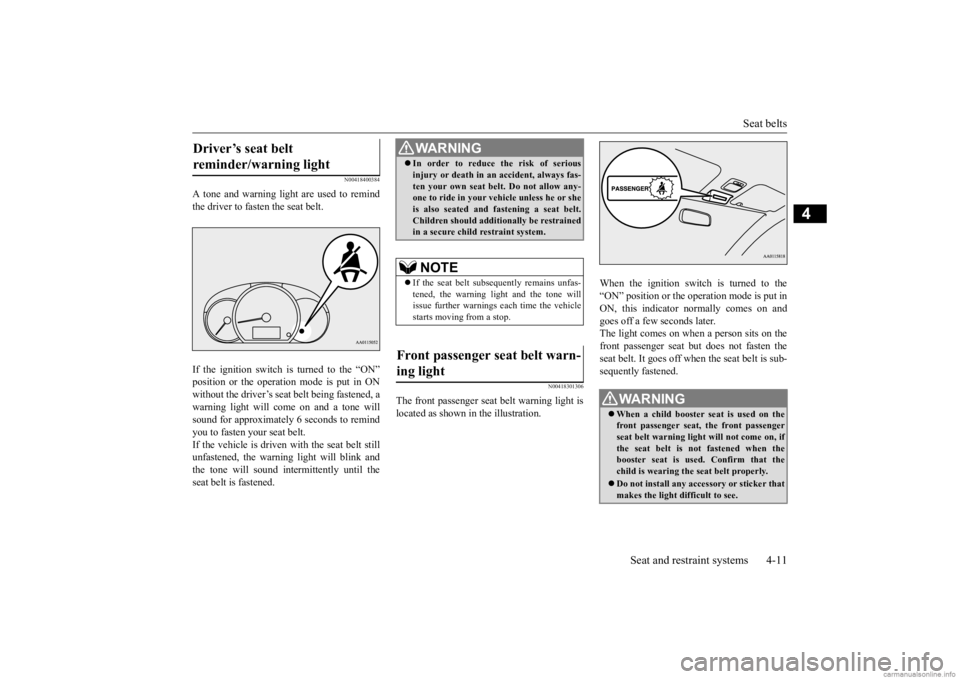
Seat belts
Seat and restraint systems 4-11
4
N00418400384
A tone and warning light are used to remind the driver to fasten the seat belt. If the ignition switch is turned to the “ON” position or the operation mode is put in ON without the driver’s seat belt being fastened, a warning light will come on and a tone willsound for approximately 6 seconds to remind you to fasten your seat belt. If the vehicle is driven with the seat belt stillunfastened, the warning light will blink and the tone will sound inte
rmittently until the
seat belt is fastened.
N00418301306
The front passenger seat
belt warning light is
located as shown in
the illustration.
When the ignition switch is turned to the “ON” position or the operation mode is put inON, this indicator
normally comes on and
goes off a few seconds later. The light comes on when a person sits on thefront passenger seat bu
t does not fasten the
seat belt. It goes off when the seat belt is sub- sequently fastened.
Driver’s seat belt reminder/warning light
WA R N I N G In order to reduce the risk of serious injury or death in an
accident, always fas-
ten your own seat belt
. Do not allow any-
one to ride in your ve
hicle unless he or she
is also seated and fastening a seat belt. Children should additi
onally be restrained
in a secure child restraint system.NOTE
If the seat belt subse
quently remains unfas-
tened, the warning li
ght and the tone will
issue further warnings
each time the vehicle
starts moving from a stop.
Front passenger seat belt warn- ing light
WA R N I N G When a child booster se
at is used on the
front passenger seat, the front passenger seat belt warning ligh
t will not come on, if
the seat belt is not fastened when the booster seat is used
. Confirm that the
child is wearing the
seat belt properly.
Do not install any acce
ssory or sticker that
makes the light difficult to see.
BK0284300US.book 11 ページ 2019年5月23日 木曜日 午後12時22分
Page 39 of 253
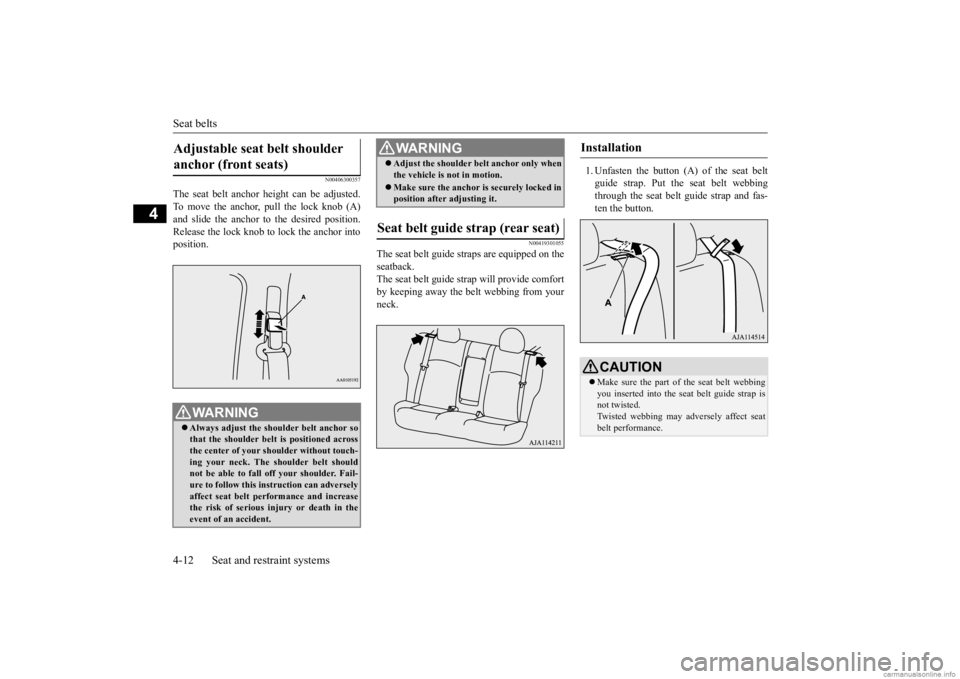
Seat belts 4-12 Seat and restraint systems
4
N00406300357
The seat belt anchor height can be adjusted. To move the anchor, pull the lock knob (A)and slide the anchor to the desired position. Release the lock knob to lock the anchor into position.
N00419301055
The seat belt guide st
raps are equipped on the
seatback. The seat belt guide strap will provide comfortby keeping away the belt webbing from your neck.
1. Unfasten the button (A) of the seat belt guide strap. Put the seat belt webbing through the seat belt guide strap and fas- ten the button.
Adjustable seat belt shoulder anchor (front seats)
WA R N I N G Always adjust the shou
lder belt anchor so
that the shoulder belt
is positioned across
the center of your shoulder without touch-ing your neck. The sh
oulder belt should
not be able to fall off your shoulder. Fail- ure to follow this instruction can adverselyaffect seat belt performance and increase the risk of serious in
jury or death in the
event of an accident.
Adjust the shoulder be
lt anchor only when
the vehicle is not in motion. Make sure the anchor is securely locked in position after adjusting it.
Seat belt guide strap (rear seat)
WA R N I N G
Installation
CAUTION Make sure the part of the seat belt webbing you inserted into the seat belt guide strap is not twisted. Twisted webbing may a
dversely affect seat
belt performance.
BK0284300US.book 12 ページ 2019年5月23日 木曜日 午後12時22分
Page 40 of 253
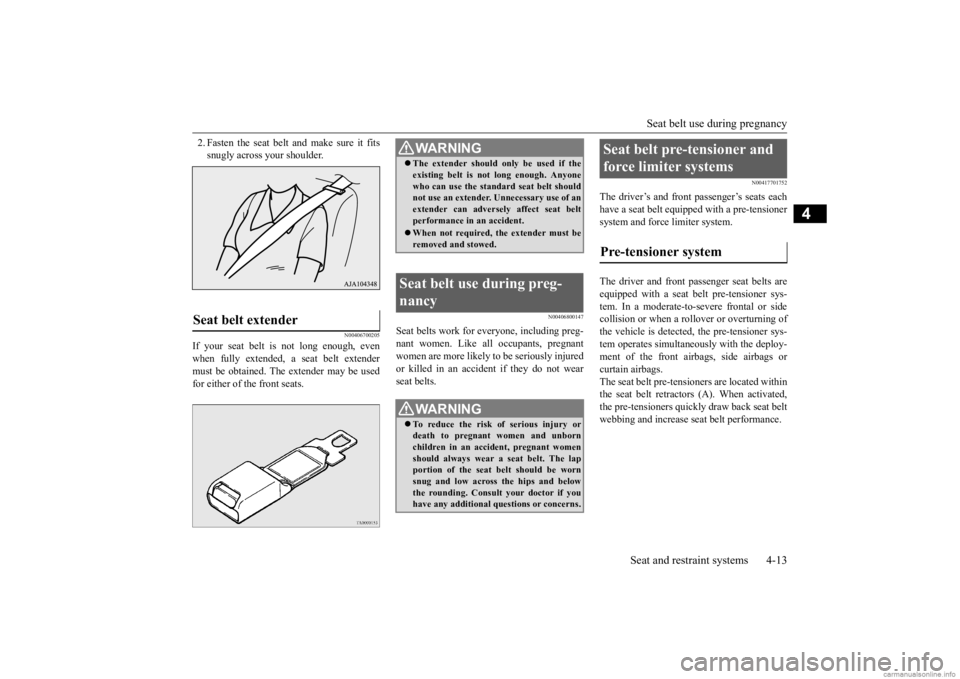
Seat belt use during pregnancy
Seat and restraint systems 4-13
4
2. Fasten the seat belt and make sure it fits snugly across your shoulder.
N00406700205
If your seat belt is
not long enough, even
when fully extended,
a seat belt extender
must be obtained. Th
e extender may be used
for either of the front seats.
N00406800147
Seat belts work for everyone, including preg- nant women. Like al
l occupants, pregnant
women are more likely to be seriously injuredor killed in an accide
nt if they do not wear
seat belts.
N00417701752
The driver’s and front passenger’s seats eachhave a seat belt
equipped with a pre-tensioner
system and force limiter system. The driver and front pa
ssenger seat
belts are
equipped with a seat belt pre-tensioner sys- tem. In a moderate-to-severe frontal or side collision or when a rollover or overturning ofthe vehicle is detected
, the pre-tensioner sys-
tem operates simultane
ously with the deploy-
ment of the front airb
ags, side airbags or
curtain airbags. The seat belt pre-tensioners are located within the seat belt retractors
(A). When activated,
the pre-tensioners quickly
draw back seat belt
webbing and increase se
at belt performance.
Seat belt extender
WA R N I N GThe extender should only be used if the existing belt is not long enough. Anyonewho can use the standard seat belt shouldnot use an extender. Unnecessary use of an extender can adversel
y affect seat belt
performance in an accident. When not required, the extender must be removed and stowed.
Seat belt use during preg- nancy
WA R N I N G To reduce the risk of serious injury or death to pregnant women and unbornchildren in an accident, pregnant womenshould always wear
a seat belt. The lap
portion of the seat belt should be worn snug and low across the hips and belowthe rounding. Consult your doctor if you have any additional qu
estions or concerns.
Seat belt pre-tensioner and force limiter systems Pre-tensioner system
BK0284300US.book 13 ページ 2019年5月23日 木曜日 午後12時22分